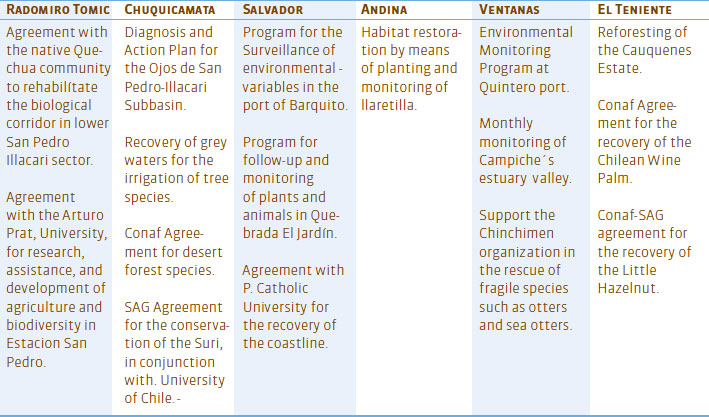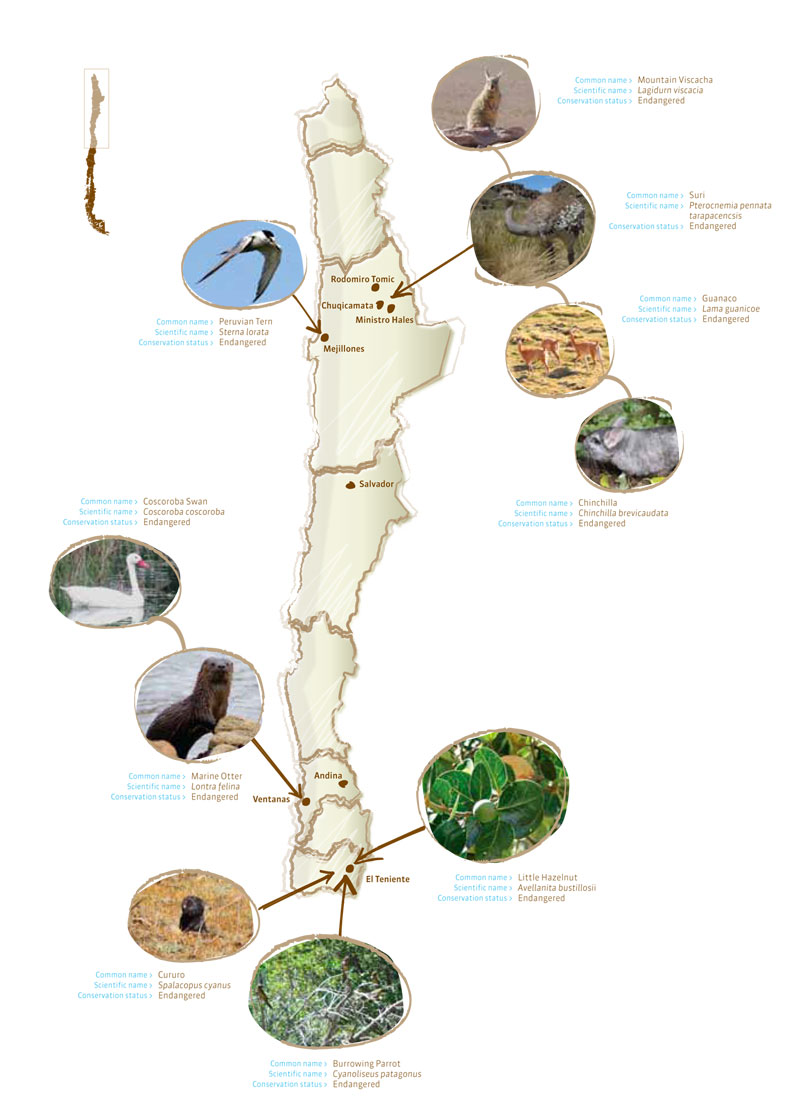Biodiversity in our environment
We recognize that the development of our activities can affect, directly or indirectly, the biodiversity that exists in the environment of our operations.
Through our commitments on biodiversity (2006) and Biodiversity Plan (2010) we assume our responsibility concerning the conservation and protection of biological diversity. With these management tools, we want to identify from each project’s initial stage the potential impacts on biodiversity, mainly on plants and animals-planning the implementation of control measures and mitigation when applicable.
Our divisions are located in an extensive portion of the national territory, not only from north to south - from the far North to the central area of Chile - but also from the Andes Mountains to the Pacific Ocean. This breadth implies a great diversity of climates, landscapes and ecosystems.
(EN11/EN12/MM2)
EN11 Location and size of land owned, leased, managed in, or adjacent to, protected areas and
areas of high biodiversity value outside protected areas. Indicate the location and size of
land owned, leased, or managed, with a high biodiversity value outside protected areas.
EN12 Description of significant impacts of activities, products, and services on biodiversity in
protected areas and areas of high biodiversity value, outside protected areas.
MM2The number and percentage of total sites identified as requiring biodiversity management
plans according to stated criteria, and the number (percentage) of those sites with plans
in place.
The biodiversity-rich areas we are responsible for
correspond to habitats that make up protected areas which have
been recognized by both the State and the divisions through
the Environmental Assessment of our projects. Two of them are
located in the Valparaiso region, in the Andina Division surroundings
(La Rinconada de Huechun Estate and Rio Blanco National
Reserve) and another in the O’Higgins region, in the surroundings
of the El Teniente Division (Los Cobres de Loncha Ecologic Estate).
The La Rinconada de Huechun Estate comprises an ecological preservation area of 1,033 hectares and another ecological protection area of 1,618 hectares. These sectors are part of an ecosystem rich in bird species, and are part of a natural resource management and conservation plan, which has a fauna surveillance program to identify possible impacts.
The Rio Blanco National Reserve, which limits with the Andina Division, has an extension of 10,175 ha. This area has no record of significant environmental impacts, so it does not have a management plan to date.
In the Los Cobres de Loncha Ecologic Estate, in the Alhué area, we find the Roblería del Cobre de Loncha National Reserve (5,980 ha),handed over by the El Teniente Division on gratuitous loan to the National Forestry Corporation (Conaf) for its management. This reserve contains plant and animal species that have been classified as vulnerable, most of them endemic, and belonging mainly to the Sclerophyll forest type. There is a management plan in place to deal with the main environmental impacts caused by the tailings dam, through programs for the reforestation of native tree species and programs for the rescue and relocation of captured individuals.
(EN13/EN14)
EN13 Habitats protected or restored.
EN14 Strategies, current actions, and future plans for managing impacts on biodiversity.
In addition to implementing measures for controlling and
mitigating our environmental impact, we have voluntarily developed
several initiatives for research, conservation and recovery
of flora, fauna, and other ecosystem elements in relation to our
work centers. The main activities in this area during 2011 are
described below.

(EN15) Number IUCN Red List species and national conservation list species with habitats inareas affected by operations, by level of extinction risk. As a result of the constant surveillance carried out by the divisions, we have identified the following plant and animal species that have been classified as “in danger of extinction”:

![]()
We are part of the Foundation for
Sustainability of the Peruvian Tern,
entity formed in 2008 along with the
Municipality of Mejillones and six other
companies, for the ends of protecting
this endangered species.
(2.10) Awards received in the reporting period. Conaf and the Ministry of Environment recognize Codelco Chuquicamata for its contribution to the afforestation and improvement of green areas in Calama.